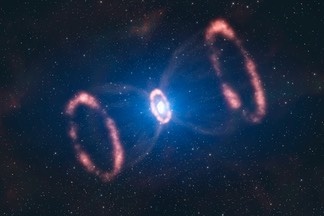Breadcrumb
- Home
- Labs
- Advanced Labs
- Properties of Nebulae
Properties of Nebulae
Main navigation
Resources: Worksheet
Terminology: Supernova, Planetary Nebula, Chandrasekhar Limit
Tutorials: Importing Images into MaxIm, Coordinates in MaxIm, Fits Header, Aligning and Animating Images
Demonstrations: Exploring the Ring, Type Ia simulation , formation of planetary nebula video
Nebula
The term “nebula” is used in astronomy to describe many objects that are inherently different from each other. Two particular kinds of nebulae explored in this lab are planetary nebula and supernova remnants, both of which are the final stages of stellar evolution.
Excluding stars with masses much less than the Sun, low mass stars are able to fuse to carbon. Once the core is carbon and fusion has stopped, the star will become an asymptotic giant branch (AGB) star, and its surface layers will begin to expand away from the star. The luminosity of the star will propel the surface layers away, until they are no longer gravitationally bound to the core. The layers will continue to expand, creating what is called the planetary nebula. The core of the star is a degenerate carbon core, called a white dwarf.
Supernova
Supernova explosions are the most powerful events in the universe and they leave behind a lasting remnant. In less than a second, as much energy is released (about 1044 Joules) as the Sun has released in its entire lifetime!
There are two types of supernovae: Type 1a and core-collapse. Within the core-collapse category, there are many sub classifications that depend on what emission lines are present in the spectrum and how the light curve behaves.
The progenitor star of a Type Ia supernova is a white dwarf. A Type Ia supernova occurs when a carbon or oxygen white dwarf becomes more massive than 1.39 solar masses, which is the Chandrasekhar limit. This can occur through mergers of two white dwarfs or when the white dwarf is in a binary with a red giant star that is larger than its Roche lobe. In the latter case, mass from the red giant accretes onto the white dwarf until the white dwarf reaches the Chandrasekhar limit.
The progenitor star for a core-collapse supernova is a high mass star ( > 8 solar masses). After the star ceases thermonuclear fusion and the core is iron, gravity takes over and begins to compress the outer layers of the star. This is an implosion, and as the outer layers of the star come into contact with the incompressible core, a shockwave is produced. This is called a core bounce. The shockwave propagates outwards, causing the explosion which we see as a supernova.
The energy in the shockwave is larger enough that fusion can happen outside of the core. It is during a supernova that the heavier elements past iron are created, which then are dispersed into the interstellar medium to seed future star formation. This process is called supernova nucleosynthesis, and it is present in Type Ia supernovae as well.

Learning Goals: Students will learn about the differences between planetary nebulae and supernova remnants.